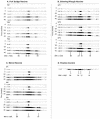Dogs vaccinated with common Lyme disease vaccines do not respond to IR6, the conserved immunodominant region of the VlsE surface protein of Borrelia burgdorferi
- PMID: 15138170
- PMCID: PMC404571
- DOI: 10.1128/CDLI.11.3.458-462.2004
Dogs vaccinated with common Lyme disease vaccines do not respond to IR6, the conserved immunodominant region of the VlsE surface protein of Borrelia burgdorferi
Abstract
A 25-amino-acid synthetic peptide (C(6) peptide) derived from an immunodominant conserved region (designated IR(6)) of the VlsE protein of Borrelia burgdorferi has been identified and used to construct immunoenzyme-based diagnostic procedures. These procedures have excellent sensitivity and specificity. Previous reports have demonstrated the usefulness of the C(6) peptide as an antigen for the serodiagnosis of human and canine Lyme disease. Results indicated that assays based on the C(6) peptide were nonreactive to sera from vaccinated nonexposed animals. The purpose of the present study was to confirm these results in a controlled trial by testing sera from experimentally vaccinated dogs known to be uninfected. Nine specific-pathogen-free beagles were assigned to one of three vaccine groups, each containing three dogs. Each group received one of three commercial Lyme vaccines: RECOMBITEK Lyme (Merial), LymeVax (Fort Dodge Animal Health), and Galaxy Lyme (Schering-Plough Animal Health). Each animal was administered a total of five doses of vaccine over a period of 39 weeks. Serum samples were collected prior to vaccination and then on a weekly basis from weeks 3 to 18 and from weeks 33 to 43. Selected samples were tested by the immunofluorescence assay (IFA) and the Western blot (WB) assay using whole-cell B. burgdorferi antigen extracts, and the results were compared to those obtained with two immunoenzyme-based procedures formatted by using the C(6) peptide. Serum specimens from all animals were reactive to the IFA and WB assay at week 5 and became highly reactive following the administration of multiple doses of vaccine. All serum specimens were uniformly nonreactive in the C(6) peptide immunoenzyme procedures at all time points throughout the study.
Figures


Similar articles
-
Evaluation of the recombinant VlsE-based liaison chemiluminescence immunoassay for detection of Borrelia burgdorferi and diagnosis of Lyme disease.Clin Vaccine Immunol. 2008 Dec;15(12):1796-804. doi: 10.1128/CVI.00195-08. Epub 2008 Oct 22. Clin Vaccine Immunol. 2008. PMID: 18945880 Free PMC article.
-
A fluorescent bead-based multiplex assay for the simultaneous detection of antibodies to B. burgdorferi outer surface proteins in canine serum.Vet Immunol Immunopathol. 2011 Apr 15;140(3-4):190-8. doi: 10.1016/j.vetimm.2010.12.003. Epub 2010 Dec 10. Vet Immunol Immunopathol. 2011. PMID: 21208663
-
Detection of multiple reactive protein species by immunoblotting after recombinant outer surface protein A lyme disease vaccination.Clin Infect Dis. 2000 Jul;31(1):42-7. doi: 10.1086/313920. Epub 2000 Jul 17. Clin Infect Dis. 2000. PMID: 10913394
-
Development of hepatitis B virus capsids into a whole-chain protein antigen display platform: new particulate Lyme disease vaccines.Int J Med Microbiol. 2008 Jan;298(1-2):135-42. doi: 10.1016/j.ijmm.2007.08.002. Epub 2007 Sep 20. Int J Med Microbiol. 2008. PMID: 17888729 Review.
-
Prevention of lyme disease: promising research or sisyphean task?Arch Immunol Ther Exp (Warsz). 2011 Aug;59(4):261-75. doi: 10.1007/s00005-011-0128-z. Epub 2011 Jun 3. Arch Immunol Ther Exp (Warsz). 2011. PMID: 21633917 Review.
Cited by
-
Vaccination against Lyme disease: past, present, and future.Front Cell Infect Microbiol. 2013 Feb 12;3:6. doi: 10.3389/fcimb.2013.00006. eCollection 2013. Front Cell Infect Microbiol. 2013. PMID: 23407755 Free PMC article. Review.
-
Seroexposure to Zoonotic Anaplasma and Borrelia in Dogs and Horses That Are in Contact with Vulnerable People in Italy.Pathogens. 2023 Mar 16;12(3):470. doi: 10.3390/pathogens12030470. Pathogens. 2023. PMID: 36986392 Free PMC article.
-
A serological survey of tick-borne pathogens in dogs in North America and the Caribbean as assessed by Anaplasma phagocytophilum, A. platys, Ehrlichia canis, E. chaffeensis, E. ewingii, and Borrelia burgdorferi species-specific peptides.Infect Ecol Epidemiol. 2014 Oct 20;4. doi: 10.3402/iee.v4.24699. eCollection 2014. Infect Ecol Epidemiol. 2014. PMID: 25405006 Free PMC article.
-
Evaluation of 2 ELISAs to determine Borrelia burgdorferi seropositivity in horses over a 12-month period.J Vet Diagn Invest. 2021 Jul;33(4):736-739. doi: 10.1177/10406387211016103. Epub 2021 May 27. J Vet Diagn Invest. 2021. PMID: 34041969 Free PMC article.
-
Current Surveys of the Seroprevalence of Borrelia burgdorferi, Ehrlichia canis, Anaplasma phagocytophilum, Leishmania infantum, Babesia canis, Angiostrongylus vasorum and Dirofilaria immitis in Dogs in Bulgaria.Parasitol Res. 2015 Aug;114 Suppl 1:S117-30. doi: 10.1007/s00436-015-4518-8. Parasitol Res. 2015. PMID: 26152413
References
-
- Barony, G., and R. B. Merrifield. 1980. The peptides: analysis, synthesis, & biology. Academic Press, Inc., New York, N.Y.
-
- Barthold, S. W., S. A. Levy, E. Fikrig, L. K. Bockenstedt, and A. L. Smith. 1995. Serologic responses of dogs naturally exposed to or vaccinated against Borrelia burgdorferi infection. J. Am. Vet. Med. Assoc. 207:1435-1440. - PubMed
-
- Gauthier, D. T., and L. S. Mansfield. 1999. Western immunoblot analysis for distinguishing vaccination and infection status with Borrelia burgdorferi (Lyme disease) in dogs. J. Vet. Diagn. Investig. 11:259-265. - PubMed
-
- Hashida, S., M. Imagawa, S. Inoue, K. H. Ruan, and E. Ishikawa. 1984. More useful maleimide compounds for the conjugation of Fab′ to horseradish peroxidase through the thiol groups in the hinge. J. Appl. Biochem. 6:56-63. - PubMed
Publication types
MeSH terms
Substances
LinkOut - more resources
Full Text Sources
Other Literature Sources

